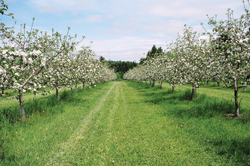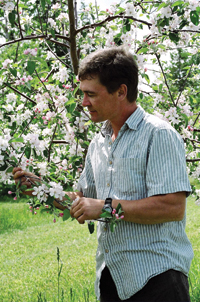
Features
Production
Research
Growing apples part of P.E.I. producer’s destiny
part of P.E.I. producer’s destiny
April 17, 2008 By Kathy Birt
Mark Ashley, who makes his home in
the community of York, Prince Edward Island, is a carpenter by trade.
But when you walk into his warehouse and see the stock of vintage apple
crates stacked high on a shelf, it becomes obvious he was destined to
grow apples.
 |
| These rows and rows of apples at Wintermoor Orchard in York, P.E.I., make up the 1,300 trees that Mark Ashley and Heather Taweel have nurtured for more than 10 years. Photo by Kathy Birt. |
Mark Ashley, who makes his home in the community of York, Prince Edward Island, is a carpenter by trade. But when you walk into his warehouse and see the stock of vintage apple crates stacked high on a shelf, it becomes obvious he was destined to grow apples.
Starting out with 250 Cortland trees in the early 90s, Ashley’s Wintermoor Orchard has grown to 1,300 trees with about 15 different varieties. He is quick to say his day job supported his orchard – an orchard he hopes will become his livelihood in the future.
“With carpentry construction you never know where you’ll be in the
winter,” he said. “So, this (apples) is my future.”
He doesn’t do it all alone.
His partner, photographer Heather Taweel, is equally involved with the orchard, right from the planting, grafting, pruning, picking and even taking pictures of the rows of beautiful spring blossoms that fill a huge field behind the 40-something couple’s home.
Both admit they didn’t know a lot about growing apples in the beginning. “There was no association at the time,” recalled Ashley. “And we were told by an agriculture Canada representative to start the branches low on the trees.”
They found out later that pruning method is for dwarfed trees. Since their orchard was semi-dwarf, the branches did not have to be that low. “It was just lack of knowledge on our part.”
 |
| Mark Ashley checks over one of the many apple trees in his Wintermoor Orchard in York, P.E.I. This orchard has 1,300 trees with about 15 different varieties. Photo by Kathy Birt. |
Taweel said the couple’s semi-dwarfed trees produce within three years, where most take about five.“Our trees will last a lot longer, and we wanted trees that will last until we’re really old,” added Ashley.
Making this happen means the couple are looking at growing more disease-resistant apple varieties. That’s where the Kentville and Bouctouche research stations in Nova Scotia came into the picture. It was researchers at these centres who helped them get into disease-resistant varieties. “We would not have had the time or money (for research),” said Ashley. “But they had a lab, which would be like a controlled orchard, where they could carry out the research.
“They were a Godsend to us.”
Charlie Embree, one of the researchers at the Kentville Research station, says some promising varieties came out in the 1980s, but it was in the 90s when growers began to grow them. Two of those disease-resistant varieties were Nova Mac and Nova Spy, he said.
“Disease-resistant varieties was the main goal of the research for a long time. It was one of those things where it was said ‘You’ll never do it.’ But we did.”
Over the past 10 years, Embree and other researchers have been speakers at regular meetings with P.E.I. apple growers, including organic growers, and the subject of scab has come up frequently. Embree said it is hard to get these disease-resistant varieties out of the nursery, so the interest from Island growers and others around the Maritimes was what they were looking for. “If they can propagate the trees themselves, they would be assured of having the opportunity to test them under their own conditions,” he said. “We speculate that these varieties will be better acclimatized to the Maritime weather.”
Having the two research stations and the researchers on the same side as apple growers from around the Maritimes is essential to the industry, believes Ashley. “The researchers are the experts and go after one specific thing,” he said, adding growers do not have the time or expertise for intricate research.
The couple sets aside any free-time from their full-time employment to continue planting and maintenance, such as mowing, mulching, pruning and wrapping trees. Through the work, the couple have been able to learn and grow (as apple growers) with their orchard.
“The first few years we selected varieties that seemed popular,” recalled Ashley.“But after a few years into the orchard, we had more information and went to disease-resistant varieties,”
Currently, the orchard is planted to Nova Spy and Nova Mac, as well as Liberty and Williams Pride, Northern Spy, Cortland and Empire, to name a few.
Taweel and Ashley also had the forethought of being more environmentally friendly with their orchard when they decided to go into disease-resistant varieties. “And it’s more economical,” said Taweel. “We don’t have to use as much spray and can spend more time maintaining the orchard.”
Even though the couple still have to spray for codling moth or apple maggot fly in the middle of the summer, they do produce under an Integrated Pest Management plan (IPM). The couple also follow an Ecological Fruit Production (EFP) plan, which includes IPM and several steps beyond that. “It teaches us the best ways to deal with grasses, the trees and storage as well as orchard cleanliness,” said Ashley.
The couple have been contacted by Beliveau’s Packers in New Brunswick and have a market for their apples there. “Our apples would be sent bulk and packed there,” explained Ashley. “In some cases, (the apples) come back to stores and supermarkets on P.E.I.”
He says the consensus is that Islanders would like to see more variety in the apples they buy, although many consumers only get a chance to try different varieties at a farmer’s market. The couple is considering adding a you-pick element to their operation.
But before the selling starts, the picking must be done. Harvest time means every spare moment is needed. And with their full-time jobs, there may not be many “spare moments.”
But Ashley is undaunted.
“Maybe, hopefully, with all the work we have put in, apples will be a
major part of our income,” he said.
Print this page